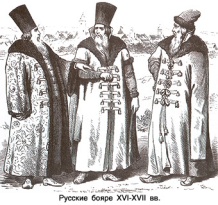Boyar Cross

The Boyar Cross was adopted by the bolyarin of a Russian Prince, Tsar or other overlord. The bolyarin were the power elite barons in a part of Eastern Europe which than was part of Russia.
Today, a main problem with Eastern Europe is that nobody wants to say they are from Eastern Europe, perhaps mainly to avoid being labelled as Russian. Rather they prefer a cool name such as Balkan, Baltic, Central European or simply Slavic.
But let's take our minds back to the time of the bolyarin. They were the highest ranking noblemen from the 10th century to the 17th century.
This cross basically follows the style of a Fleur de Lis Cross. The fleur de lis is a mark of the aristocracy and these nobles had the right to have their own coats of arms. The Boyar Cross differs in that the 'petals' curve round (like the anchor of a Croix Ancrée) so that they touch the petals of adjoining cross arms, thereby forming four heart shapes.
This heart shape is also similar to the Cyrillic 'C' shapes on the Serbian coat of arms (see Serbian Cross). It also resembles the Greek β, four of which form an acronym of the imperial motto of the Palaiologos dynasty, the last ruling dynasty of the Byzantine Empire: Basileus Basileon, Basileuon Basileuonton (King of Kings, Ruling Over Kings).
 | ||
 |  | |
 | ||
| (Click any photo to enlarge) | ||
The photos here show a sterling silver Boyar Cross. It is clearly marked with an Orthodox Cross in the centre (click any photo to enlarge), which is a three-bar cross with a slanting suppedaneum (foot support).
Dr Alexander Roman kindly gave us the following explanation:
On the left arm are the raised letters "IC", and on the right arm are the matching "XC". The set of letters IC-XC is the acronym for Jesus Christ and the lettering conforms to a Church canon from one of the ecumenical councils which demands that all crosses of Christ be signed with the Christogram to indicate 'whose' cross it is, since crucifixion was at that time still practiced.
At the top of this cross we see letters signifying Trb Slbu (King of Glory). This was often placed over the "IHTSIU", the Slavonic INRI.
Toward the bottom is both the "NUKA", which in the Russian tradition were the four letters for the words "N(On Golgotha) U(He saved) K(by His Blood) A(Adam)".
There are also the letters "HA" in Cyrillic lettering at the bottom which signify the 'head of Adam' as per the tradition that the Cross was placed on top of the grave of Adam. Thus we often see the skull and crossbones at the foot of the Cross and especially Orthodox renderings of the Cross.
Finally, on either side, the letters in Slavonic "K" and "T" which signify spear and reed, both being of the Armoury of Christ.
A couple of other crosses, with pretty much the same design, were discovered about 5,000 kilometres to the southeast, in India. (Click any photo to enlarge)
According to the Nasrani Syrian Christians Network website (nasrani.net) the cross on the left was found at the ruined Christian settlement of Nilakkal, Kerala. This settlement is believed to have been founded by St. Thomas.
The cross on the right is described on the same website as carved by Mar Sabore and Mar Prothe in about 880 AD. This cross is at Kottakkavu, North Parur, on the coast of Kerala. They are both described as Persian Crosses.
It's interesting to note how the Indian (Nasarani) Cross pattern and the Boyar Cross have both morphed into such similar patterns, quite different from the simple shape of the actual cross used to crucify Jesus.

Various English singular and plural spellings of the title depend on region and period. They include: boyar and boyars; bolyar and bolyars; bolyari and bolyarin; bojar and bojaren; bilyar; boila, boilar, boilades or boliades (not boiler-men!)






